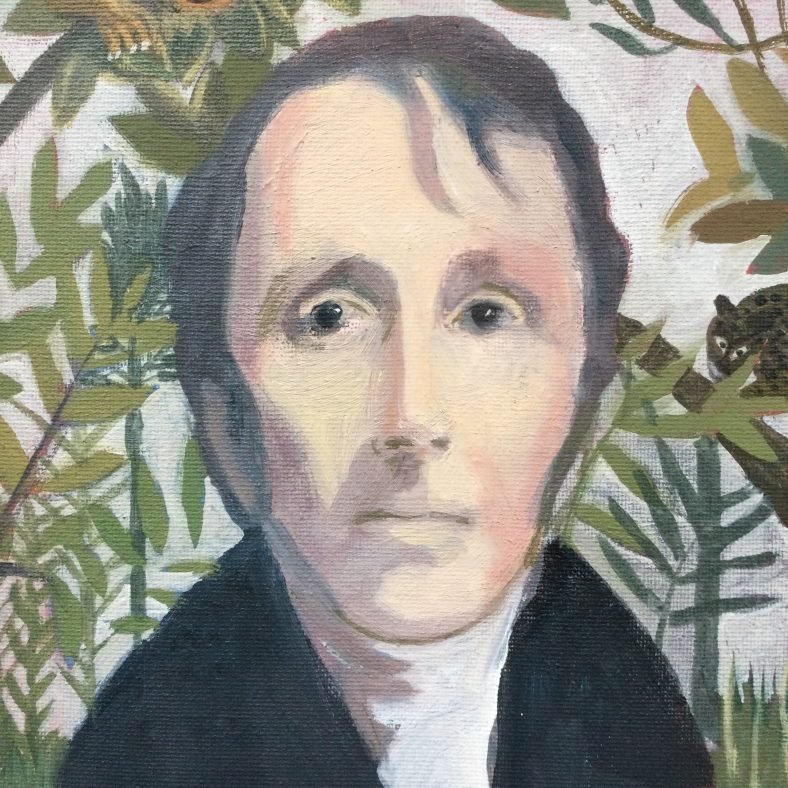William Ellery Channing and ‘Nature’ [by Richard Crawford]
Painting of William Channing by Richard Crawford
In the Newington Green Meeting House library, I was recently shown a large bound volume of the writings of William Ellery Channing, a Unitarian preacher and theologian who lived in New England from 1780 to 1842. It was published in London in 1884, long after his death, and entitled: ‘The complete works of William Ellery Channing DD. including ‘the perfect life’ and containing a copious general index and a table of scriptural references’. The index is a wonderfully comprehensive list of all the topics covered in the separate sections of the book; what we would now call an ‘analytic index’. It enabled me to trace all the references Channing made on any topic he had written about. I decided to find out what he had to say, from a Unitarian point of view, on a topic we are all concerned about at the moment: ‘Nature’.
There is a lot of rhetoric in Channing’s essays, mainly because he intended to deliver them as sermons, but underneath the verbal flourishes Channing emerges as a Creationist who believed that the world and every living thing in it, was created as the Bible said it was, by an omnipotent Creator. “Nature everywhere testifies to the infinity of its author” (7). He was sensitive to the natural beauty of the world, reading it as a sign or symbol of the “infinite power, intelligence, bliss and love” (8) that had gone into it’s making, but he glossed over all the unpleasant aspects of the nature, merely remarking that natural disasters helped us to appreciate the power of the Creator (8). Interestingly, he roll-calls disaster such as ‘the roar of the ocean, thunders, whirlwinds and conflagrations’ as ‘bursts of praise’ to the Almighty. In today’s America, forest fires, hurricanes, rising sea levels and tornados would be seen unwelcome signs of global warming.
Channing was a man of his times. It was common sense in the 19th century to see humans as the top species in the ‘Scala Natura’. His reason for putting humans above other species of animal was that they possessed a ‘soul’ that animals lacked. The evidence for this, Channing argued, was that animals attended only to their physical needs, whilst humans sought spiritual meaning to their lives through the practice of art and religion. In today’s less anthropocentric world, his argument sounds like a case of human exceptionalism, because it promotes the importance of human propensities whilst overlooking all the many extraordinary characteristics other animal species have evolved in order to survive in their environment that far exceed human capabilities. It also presumes knowledge of the inner lives of animals that Channing could not possibly have had access to.
Channing seems to have believed in a form of ‘vitalism’ – the idea that nature is animated by some invisible force. Nature’s “exquisitely ordered whole’, he maintained, is blended by ‘spirit’ (30). Whilst biological materialists would argue that the nature of all living creatures can be explained in terms of biochemistry, some 19th century biologists, such as Louis Pasteur, Jons Berzelius and Johannes Peter Muller tried to find experimental proof that a ‘life force’ exists. They were unsuccessful in their attempts, and vitalism subsequently faded as an active branch of biology.
Another questionable assumption Channing held was that Nature “testifies to a Good Creator” (30). In the midst of a Covid Pandemic, this seems like a very rosy picture of the organic world. How many people who have suffered illness, distress and bereavement would agree with his assessment now? A Romantic attachment to the idea of Nature as ‘sublime’, ‘beautiful’ and ‘spiritual’ seems to infuse Channing’s writings. In one passage he breaks into poetry to describe “the hour when the morning stars sang for joy over the new born earth” (7). His response to Nature was deeply affective.
In a confusing passage, he credits humans with the ability to “imitate the creative powers of Nature” through technology in order to become a “co-creator with Himself”(31). Little did Channing realise how human technology would go on to threaten the very existence of ‘God given’ nature. From the perspective of the mid 19th Century, the destruction of the ozone layer by the internal combustion engine in the current century could not even be imagined.
Page numbers refer to pages in ‘The complete works of William Ellery Channing DD. including ‘the perfect life’ and containing a copious general index and a table of scriptural references’. London 1884
This blog is licensed under the Creative Commons Attribution 4.0 International license. It was made by New Unity and Richard Crawford. Find out more: https://creativecommons.org/licenses/by/4.0/.

